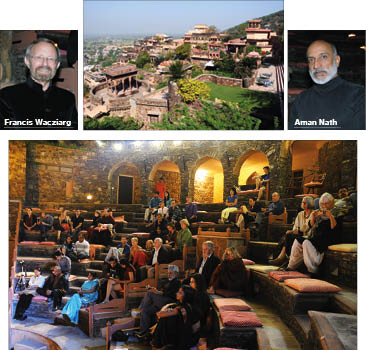This week, the Aravalli Hills on the Haryana-Rajasthan border literally ‘came alive with the sound of music’, with a gripping performance of an exclusive Opera-Pastiche, ‘Alexander The Great In India’ – performed in the unusually spectacular setting of Neemrana Fort-Palace’s open-air amphitheatre. What made this Opera remarkable was its international cast of Sopranists, dancers and musicians from France, America, Germany and India.
Credit must be given to Francis Wacziarg, and his partner Aman Nath, for restoring and transforming some of India’s beautiful and ancient heritage-sites into designer-retreats. They make such exquisite settings and cultural venues for creative expression. Falling completely in love with India three decades ago, in his thirties, Francis became an Indian citizen many years ago.
As a longtime opera-aficionado, Francis has taken the initiative to present several authentic European operas in various Indian cities. Having lived extensively in Europe, and as a longtime Opera-fan, I long to see a suitably-inspiring Indian version of my all-time favourite ‘La Boheme’ – Puccini’s moving and beautiful 1896 saga of the lives of struggling painters in Paris’ Latin Quarter (a zone where I have painted as a young artist). The unmatchable quality of the Operatic genre is its Magic Realism: the best Opera is as ‘real’ as it is ‘magical’.
Conceptualised by Francis’ daughter Aude Priya, Alexander’s operatic theme is perfectly suited to an Indian ethos. The legend of this flamboyant Greek conqueror has been interpreted in various ways, over the centuries, by several European Opera-writers. Aude, who was born in Mumbai, and is now an Overseas Citizen of India, studied Greek mythology and classical music, and was hence keen on presenting this ‘Pastiche’ in India. With a vibrant group of performers, and a timelessly-striking Greco-Roman amphitheatrical open stage-setting—specially designed by Francis and Aman—
the two-hour performance was ideally visualised.
‘Allessandro Nell’Inde’ (‘Alexander in India’) is the original Libretto by one of Italy’s most famous opera-writers, Pietro Metastasio. The play that Pietro penned on Alexander’s campaign in India proved so popular that it inspired over 70 composers to set it to music --- from Vinci’s 1729 version, to Puccini’s 1824 opera. Technically, the Neemrana Palace version falls into the Operatic genre ‘Pasticcio,’ or Pastiche --- a popular European performance-style that consists of an arrangement of songs by a variety of renowned composers, all following a common storyline. Such Pastiches were frequently staged in 18th-C. Europe; here, Aude-Priya has carefully selected a fine bouquet of more than a dozen classical compositions and Arias – by Handel, Bach and others. These are discerningly arranged into a composite of musical, dance and acting methodologies. Our own ancient Indian dramatic folk-narratives, such as Pandavani and Baul-sangeet, utlise this very same Pastiche method --- one that includes song, theatre and dance; Bollywood merely being a modern extension of the same.

The cast, orchestra and choir of Alexander included the stellar American Sopranist Robert Crowe, who lives in Germany; the Franco-Indian Sopranist Aude Priya; the noted American-Indian Modern and Kathak dancer Justin McCarthy – on the Harpsichord; Nathalie Ramirez Tovar on the Flute; Malti Shyam as lead dancer and Choreographer; Hemant Kalita, lead dancer as Alexander; Tapan Mullick on Cello; Utpal Ghosh on Tabla; costumes by Parvesh and Jai; and Mallika Taneja as narrator. This expressive team deftly conjured up the melodrama, love-intrigues, obsessions, egotism and flamboyance of 326 B.C.
In that fantastic epoch, on the banks of the Indus (called River Hydaspes in the Opera), a daring young Greek soldier called Alexander defeated the Indian King Poro --- thus setting off a complex chain of cross-cultural currents in North Indian history. In a deft subtle touch, the Indian performers, Hemant and Malti, depicted the Opera’s Greek personae; while the Europeans, Robert and Aude, depicted the Indian Raja Poro and his queen. There was not a single false note.

The opening Allegro by Handel, ‘Se mai turbo il tuo rispose’ (My turmoil in your repose) stirringly reflected the turbulence of Alexander’s presence in India. In Part II, Bach’s Prelude was magnificent; as was Handel’s ‘Caro, Dolce’ (Sweet Care) in Part III’s Conclusion. The Indian dancers, Hemant and Malti, stood out with the fluid beauty of their Kathak-inspired movements. Robert was an outstanding Sopranist as King Poro; and Aude Priya’s trilling, bird-like sopranos bore a mellifluous tonality. One cannot fault the two European Sopranoes in either their discipline or emotion.
It is my fervent suggestion that Indian singers, writers and musical compositions should also be a part of future operas. The absence of Sanskrit or Indian linguistics was a lacuna in this presentation. Future productions must also employ far more flamboyant costumes and adornments, that utilise more authentic Indian brocades, jewellery and embellishments. Visually, as stage-essentials, truly operatic, larger-scale and stronger set-designs, as well as more advanced sound-effects, must be rigorously applied. The ‘lightweight’ visual effects in this Opera were more like those of an ‘in-house’ production.
At Neemrana, for a few magical hours, one believed that this world can, indeed, be one. Bravo to the admirable joi de vivre and bonhomie of Francis’ international vision of a world that can be joyously united by Culture. Amid the echoes of all manner of delicate Arias, this was the final Truth of the production – watched in an eternal amphitheatre by all the silent shadows lurking within an ancient Indian Palace.
Artist, Writer, & Curator
The Opera was repeated at Delhi’s Teen Murti auditorium.
Read More...